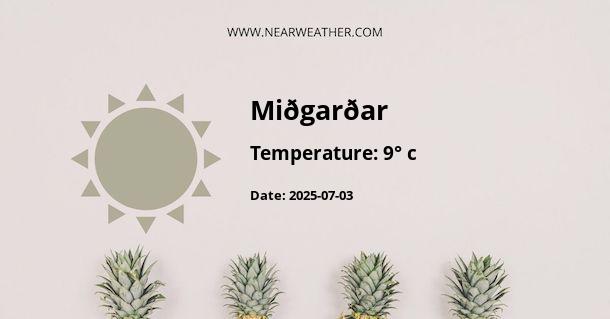Climate and Weather in Miðgarðar, Iceland
Located in the North Atlantic Ocean, Miðgarðar, Iceland experiences a unique climate characterized by its high latitude and proximity to the Arctic Circle. The weather in Miðgarðar is influenced by various factors, including ocean currents, atmospheric patterns, and the country's rugged topography. The region is known for its dramatic weather changes, diverse landscapes, and extreme conditions. Let's explore the climate and weather patterns in Miðgarðar throughout the year.
Seasonal Overview
1. Winter (December - February):
During winter, Miðgarðar experiences long nights and short days due to its high latitude. The average temperature ranges from -2°C to 2°C (28°F to 36°F), with occasional drops below freezing. Snowfall is common, especially in the higher elevations and mountainous areas. The region is also prone to strong winds and storms, which can create blizzard-like conditions.
2. Spring (March - May):
As spring arrives in Miðgarðar, the days gradually become longer, and temperatures start to rise. However, the weather remains volatile, with frequent fluctuations. The average temperature ranges from 1°C to 7°C (34°F to 45°F). Spring is characterized by a mix of sunny and rainy days, and occasional snowfall can still occur.
3. Summer (June - August):
Summer in Miðgarðar brings long days and mild temperatures. The average temperature ranges from 8°C to 13°C (46°F to 55°F), with occasional heatwaves pushing the mercury above 20°C (68°F). The region experiences the midnight sun phenomenon, where the sun remains visible for 24 hours a day. This is a popular time for outdoor activities, as the landscapes are filled with vibrant greenery and blooming wildflowers.
4. Autumn (September - November):
Autumn in Miðgarðar is characterized by cooler temperatures and shorter days. The average temperature ranges from 4°C to 9°C (39°F to 48°F). The region experiences colorful foliage as the leaves change, creating a picturesque landscape. Rainfall increases during this season, and winds can be strong. Snowfall may also occur towards the end of autumn, especially in higher elevations.
Precipitation
Miðgarðar receives a significant amount of precipitation throughout the year, with the highest rainfall occurring in the coastal areas and the southern parts of the country. The precipitation in Miðgarðar is primarily in the form of rain, but snowfall is common during the winter months. On average, Miðgarðar receives around 800-900 millimeters (31-35 inches) of precipitation annually.
The graph below illustrates the average monthly precipitation in Miðgarðar:
Month Precipitation (mm) January 80 February 80 March 70 April 60 May 50 June 60 July 70 August 80 September 90 October 100 November 90 December 90
Sunlight Hours
Due to its high latitude, Miðgarðar experiences significant variations in daylight hours throughout the year. The region witnesses the phenomenon of the midnight sun during summer, where the sun remains above the horizon for 24 hours a day. Conversely, in winter, the days are short, and the sun may be barely visible at times.
The table below shows the average monthly sunlight hours in Miðgarðar:
Month Sunlight Hours January 2 February 4 March 7 April 11 May 15 June 21 July 19 August 16 September 12 October 8 November 4 December 2
Extreme Weather Events
Miðgarðar is known for its extreme weather events, which can pose challenges to residents and travelers. Here are some notable weather phenomena:
- Storms: Miðgarðar experiences powerful storms, often accompanied by strong winds and heavy rainfall. These storms can cause disruptions to transportation and infrastructure.
- Blizzards: During winter, blizzards can occur, bringing heavy snowfall, strong winds, and low visibility. These conditions can be dangerous for outdoor activities and travel.
- Volcanic Activity: Iceland is home to numerous volcanoes, and volcanic eruptions can have an impact on weather patterns. Ash clouds from volcanic eruptions can disrupt air travel and affect weather conditions for an extended period.
- Glacial Melt: In the summer months, glacial melt can lead to increased river levels and potential flooding in certain areas.
Conclusion
Miðgarðar, Iceland experiences a diverse and dynamic climate throughout the year. From the long, dark winters to the bright, sunny summers, the weather in Miðgarðar showcases the region's unique geographical location. The precipitation, temperature, and sunlight hours vary significantly across the seasons, providing a range of experiences for those visiting or residing in Miðgarðar. It is essential to be prepared for the region's extreme weather events and to monitor weather forecasts and warnings to ensure safety and enjoyment while exploring this beautiful part of Iceland.
A - Miðgarðar's Latitude is 66.537712 & Longitude is -17.951180.
A - Weather in Miðgarðar is 6° today.
A - Climate Conditions in Miðgarðar shows overcast clouds today.
A - Humidity in Miðgarðar is 85% today.
A - Wind speed in Miðgarðar is 14.29 km/h, flowing at 217° wind direction. today.
